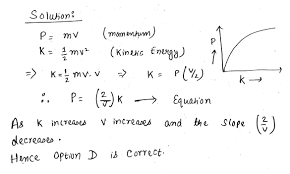
relation between kinetic energy and momentum
An introduction to relation between kinetic energy and momentum
Name: Own Teacher
Email: info@ownteacher.com
Created At: 31-10-2023
Kinetic energy and momentum are the two terms related to an object in motion. In this article, we will explore the relation between kinetic energy and momentum.Kinetic Energy
The kinetic energy of an object is the energy associated with the object which is under motion. It is defined as “the energy required by a body to accelerate from rest to stated velocity.” It is a scalar quantity.
Kinetic Energy Formula
Mathematically expressed as-
k.e=½mv2
Where,
m is the mass of the object measured in kg.
v is the velocity of the object measured in m/s.
Kinetic Energy Unit
The SI unit of Kinetic Energy is Joules.
Momentum
The momentum of an object is the virtue of its mass. It is defined as the product of mass and velocity. It is a vector quantity.
Momentum Formula
The momentum of a moving object can be mathematically expressed as –
p = mv
Where,
- p is the momentum.
- m is the mass of the object measured using kg.
- v is the velocity of an object measured using m/s.
Momentum Unit
The SI unit of Momentum is kg.m/s.
Relation between Momentum and Kinetic Energy
Kinetic energy and momentum of a moving body can be mathematically related as follows-
Consider the formula of kinetic energy-
Hope you have understood the relation between Kinetic energy and momentum of a moving object.
Frequently Asked Questions – FAQs
Q1
What is kinetic energy?
The kinetic energy of an object is the energy associated with the object which is under motion. It is defined as “the energy required by a body to accelerate from rest to stated velocity.” It is a vector quantity.
Q2
Define momentum.
The momentum of an object is the virtue of its mass. It is defined as the product of mass and velocity. It is a vector quantity.
Q3
State the law of conservation of momentum.
The law of conservation of momentum states that in an isolated system the total momentum of two or more bodies acting upon each other remains constant unless an external force is applied. Therefore, momentum can neither be created nor destroyed.
Q4
The law of conservation of momentum is based on which law of motion?
The law of conservation of momentum is based on Newton’s third law of motion which states that every force has a reciprocating equal and opposite force.
Q5
What is the formula for the law of conservation of momentum?
The momentum observation principle can be mathematically represented as:
m1u1 + m2u2 = m1v1 + m2v2
In the equation, m1 and m2 are masses of the bodies, u1 and u2 are the initial velocities of the body.
v1 and v2 are the final velocities of the bodies.
Comment List
Leave a Comment.



